North Vietnam, Opening of the Railway from Hanoi to Muc Nam Quan, March 1, 1956 (Michel Nr. 31-34); After the railroad infrastructure in North Vietnam had been relentlessly attacked first by the Viet Minh and later by American bombing raids assisting the French, the Viet Minh began with the reconstruction of the Hanoi line to Quan Nam shortly after the agreement reached at the Geneva Convention in 1954. The coastal line to Quan Nam (a bit south of Da Nang) was reopened on March 1st, 1956. The stamps were again produced at the Vietnam National Bank Printing Works in Hanoi on thin paper and with rather poor perforation. Given high inflation the nominals were higher than in the past with the four stamps showing 100D, 200D, 300D and 500D in value.
The color range of this issue is quite variable as can be seen by comparing these pairs below. It is no so much that different printing colors were used for the various printings but that the color adjustment, that allows more or less color flow to the plate, was adjusted very differently.
Here is the set in blocks of four
In the 1950’s the perforation combs sometimes struck in an irregular pattern like on this pair of the 500D value. This has to do with the fact that the perforation was performed manually. Notice that the bottom stamp is quite a bit taller than the top stamp. 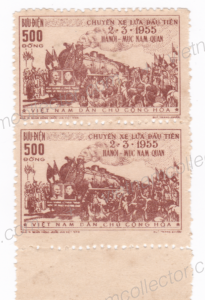
As is true for all stamps issued in the 1950 postally used samples are really hard to find. Both, Michel and Scott, value postally used stamps lower than mint ones and based on market availability that makes very little sense. As a matter of fact valuing a mint set at $/€160 is much too high for this set. One can usually acquire it for around $/€50. That is not true for a postally used set as it is basically never offered. One has to painstakingly collect individual stamps one by one in order to complete a set. So, a postally used set should cost a multiple of a mint set.
Beware of cancelled to order specimens such as the ones below. They are worth only a fraction of postally used stamps. Remember the catalogue values are for postally used stamps. They are easily recognizable by the typical Hanoi corner cancels that do not show more than 25% of the cancel as it was always struck across four stamps at the same time.
Here is a perforation error on the 100D stamp. It is imperforated on the right.
Very rare multiple franking of the 100D Railroad value (3) paying the standard surface letter rate from Hai Phong to the Soviet Union in April of 1956. The letter was mailed by a member of the North Vietnamese Military to what was, most likely, a fellow solider that was in training in Moscow. The letter carries two red cachets “TBSMBD” (=Soldier Mail/Letter). Hanoi machine transit cancel on the reverse. Moscow arrival circular data canceller from May 15th, 1956 (so the letter took 24 days). Rectangular Moscow Airport USSR stamp on front. Domestic military letter at that time were transported free of charge but stamps were required for international letters.
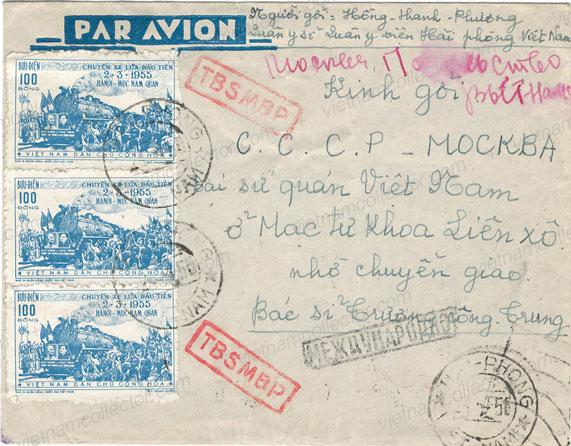
Complete letters are equally rare and hence hard to find. Below is a local letter than was most likely philatelically inspired .It carries a rate of 110 Dong which does not quite match the 100 Dong rate in force in 1955. It carries one 100D railway stamp and one overprinted HCM and Map devalued to 10D.
Mixed franking of the 100D and 500D value on a letter sent in July of 1956 by a member of the East German Embassy to a colleague on East Berlin paying the required air mail rate. Red “Apres Depart” hand stamp on front.
Mixed ranking of the 100D Railroad stamp together with the 500D Production and Thrift stamp paying an overall postage of 600D on an international air mail letter sent from a member of the East German Embassy in Hanoi to a family member in Dresden. This was the correct postage for a letter weighing between 5-10 grams. Note the very light color of the railroad stamp.
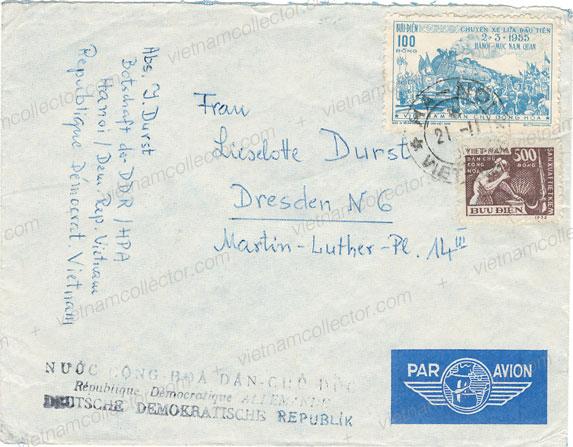
Rare multiple franking of the 200D Railroad stamps (3) paying the international air mail rate from Hanoi to East Germany of 600D. Red “Hanoi-Canton” air mail cachet. Red “Apres Depart” cachet on front. The letter originated from a member of what was a East German medical group that provided assistance to a fellow socialist country.
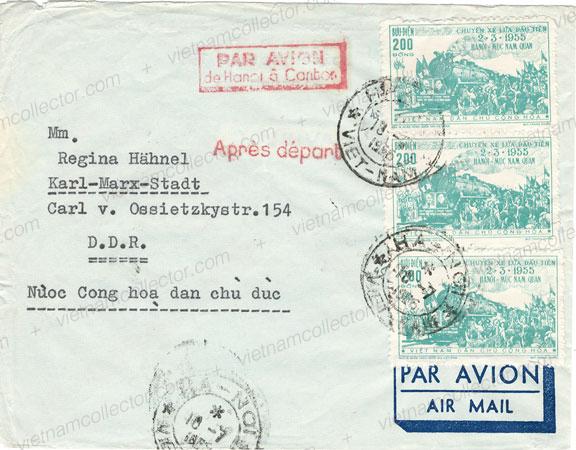
Mixed franking of the 200D Railroad stamps (3) together with the 50D Liberation of Hanoi stamp paying an overall postage of 650D (300D base rate plus 350D for air mail surcharge) on an international air mail letter sent from Hanoi to West Germany. The letter requested an air mail route via Canton in China but this was manually changed to Peking (Beijing). Also while the top left of the letter states “Recommandee” it was not sent registered as is also evidenced by the postage. Registration surcharge alone would have amounted to 600D at the time so an overall postage of 1,250D would have been required. Ex Klewitz.
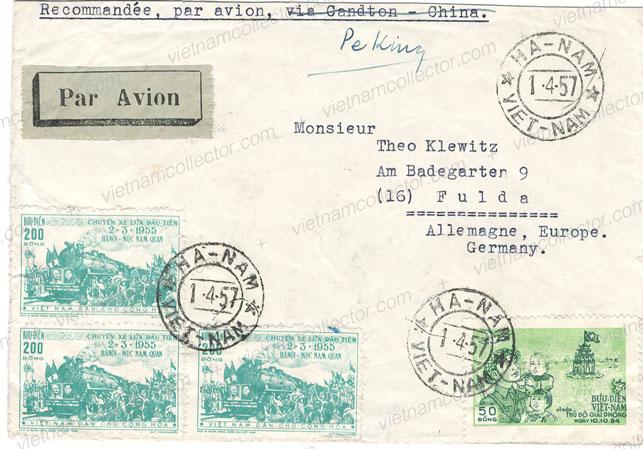
Mixed franking of the 300D Railroad stamps together with two 10D Dien Bien Phu and one 500D Production and Thrift stamps paying an overall postage of 820D on an international air mail letter sent from Hanoi to The Soviet Union in August of 1955. The standard surface letter rate at the time amounted to 300D and the air mail surcharge 270D for the first 5 grams of weight. So, this letter must have been quite a bit heavier than 5g. Interesting red boxed “de Hanoi a Canton” air mail routing stamp. Moscow arrival cancel on the reverse.
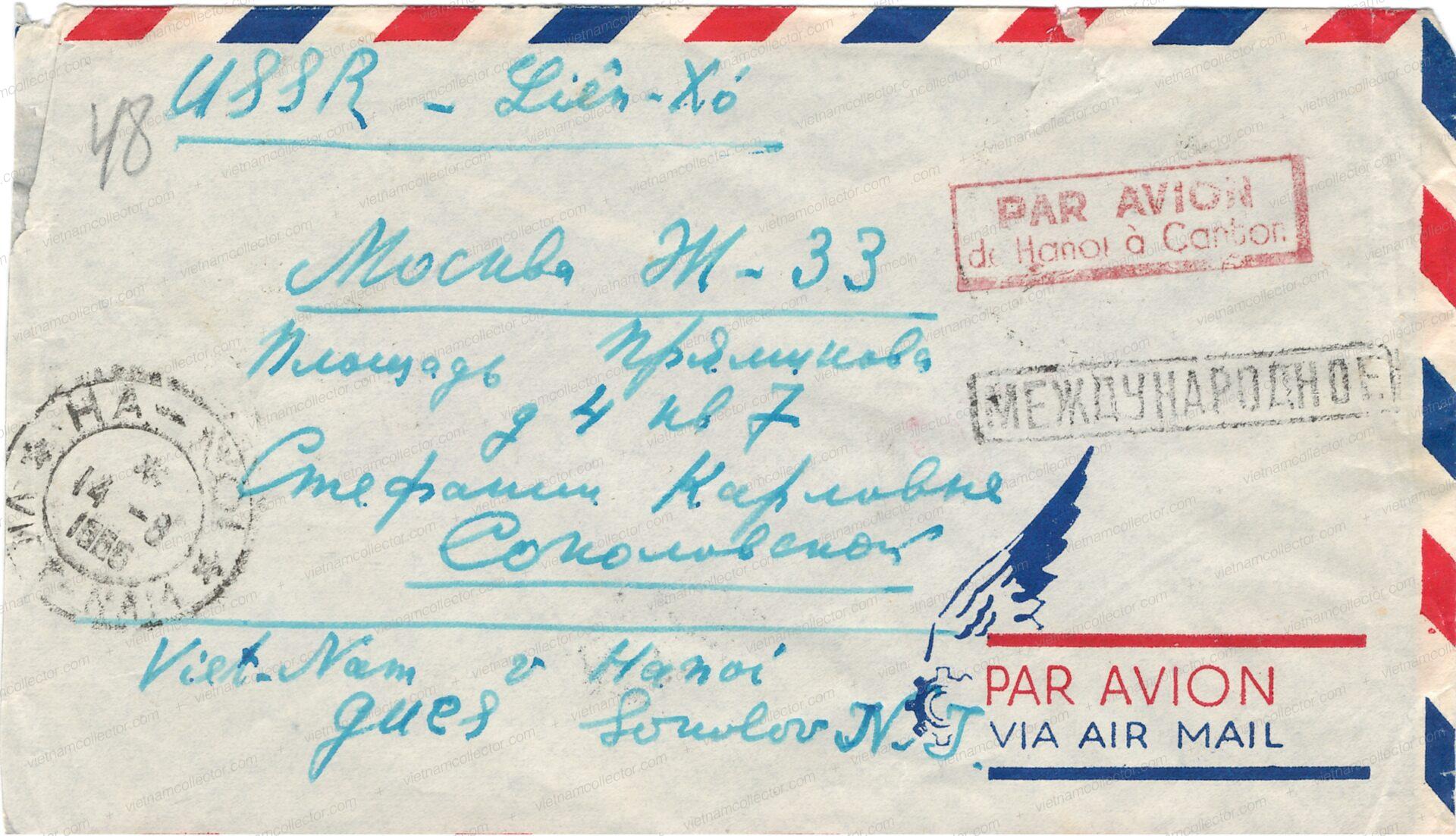
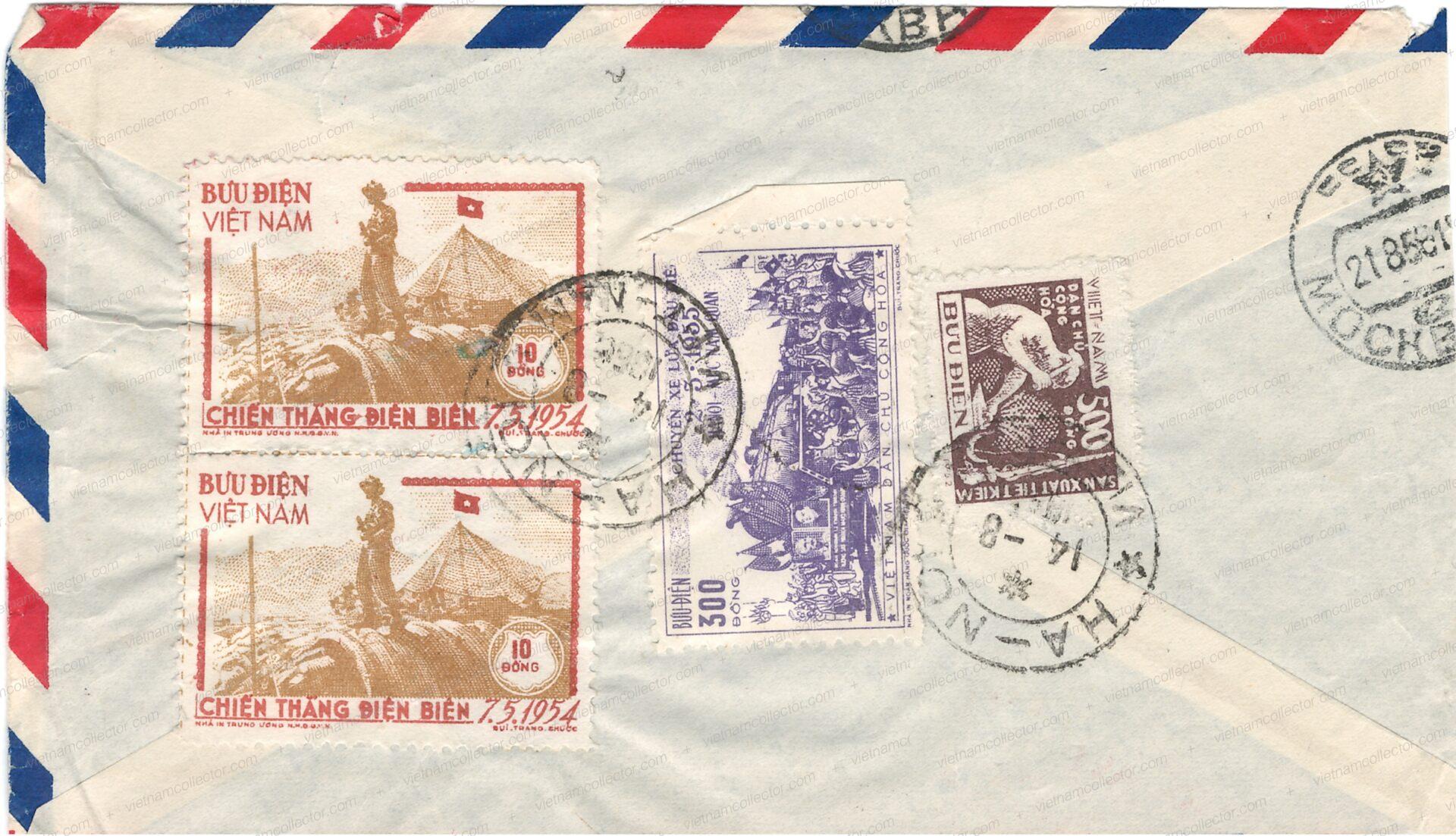
Rare multiple franking of the 300D Railroad stamps (2) paying an overall postage of 600D on an international air mail letter sent from Hanoi to East Germany in August of 1956. Red “Hanoi to Canton” air mail cachet on front. The letter originated from a member of what was a East German medical group that assisted a fellow socialist country.
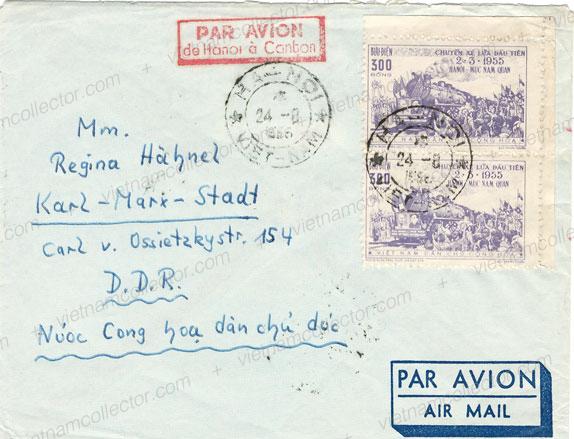
Mixed franking of the 100D Production and Thrift stamp together with the 500D Muc Nam Quan Rail line stamp paying an overall postage of 600D. From July 1st, 1955 through March 13th, 1957 the surface rate to Eastern Germany amounted to 300D and the surcharge for air mail amounted to 270D for every 5 grams of weight so this letter was likely mailed in June of 1955 or 1956 and weighed between 5 and 10 grams.

Mixed franking of the 20D Agrarian Reform stamps (2) together with the 300D and 500D Railroad stamps paying an overall postage of 840D on an international air mail letter sent from Hanoi to East Germany in March of 1956. The standard surface letter rate at the time amounted to 300D and the air mail surcharge 270D for the first 5 grams of weight. So, this letter must have been quite a bit heavier than 5g.
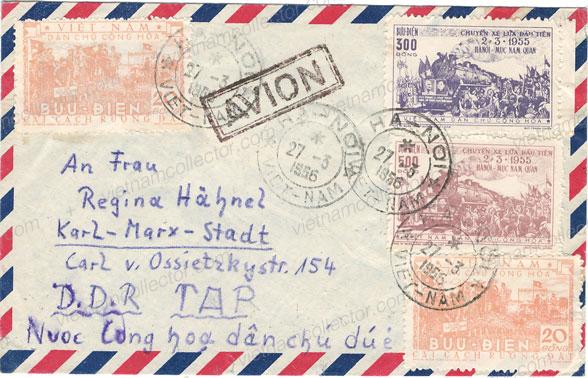
Mixed franking of the 20D Agrarian Reform stamps (2) together with the 300D and 500D Railroad stamps paying an overall postage of 840D on an international air mail letter sent from Hanoi to East Germany in April of 1956. The standard surface letter rate at the time amounted to 300D and the air mail surcharge 270D for the first 5 grams of weight. So, this letter must have had a weight of 10g and was slightly overpaid by 10D.
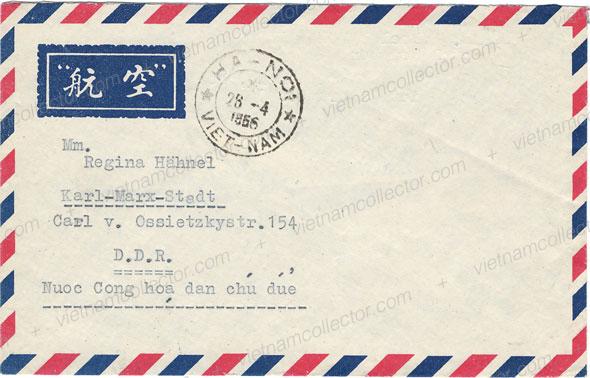
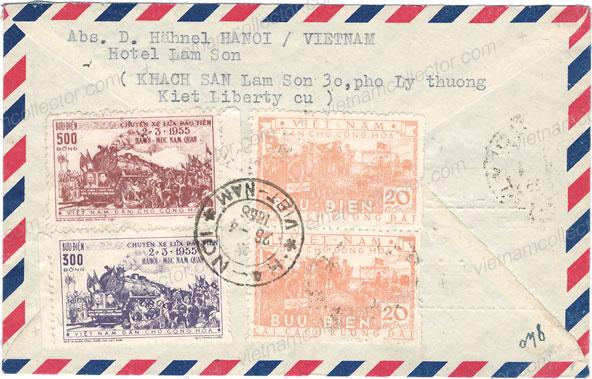
Mixed franking of the 20D Agrarian Reform stamps together with the 300D and 500D Railroad stamps paying an overall postage of 820D on an international air mail letter sent from Hanoi to Czechoslovakia in April of 1956. The standard surface letter rate at the time amounted to 300D and the air mail surcharge 270D for the first 5 grams of weight. So, this letter must have had a weight of 10g.
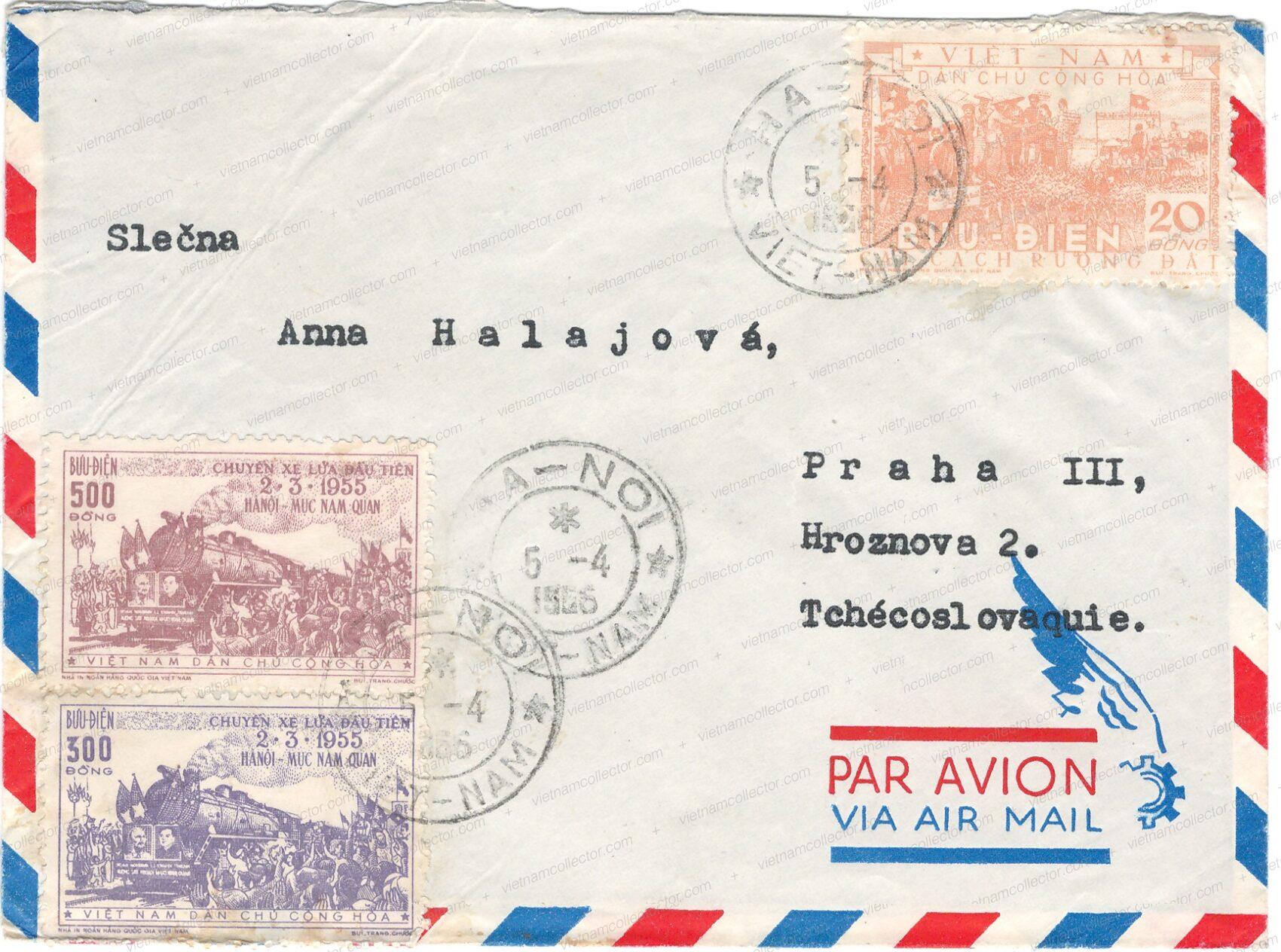
Mixed franking of the 500D railroad value plus the 100D Tran Dang Ninh stamp sent in July of 1956 by a member of the East German Embassy to a colleague on East Berlin paying the required air mail rate.
Mixed franking of the 300D and 500D Railroad stamps together with four 10D Dien Bien Phu stamps paying an overall postage of 840D on an international air mail letter sent from Hanoi to East Germany in June of 1956. The standard surface letter rate at the time amounted to 300D and the air mail surcharge 270D for the first 5 grams of weight. So, this letter must have been quite a bit heavier than 5g.
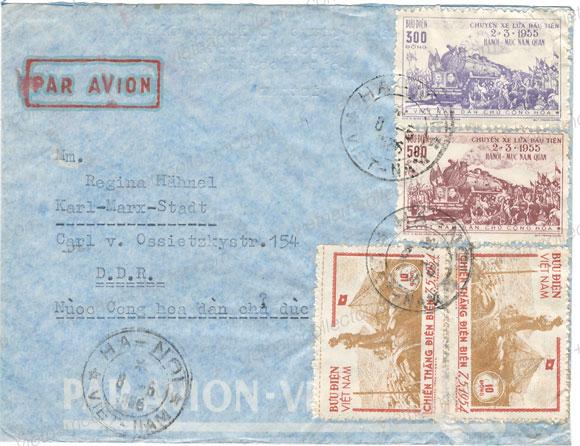
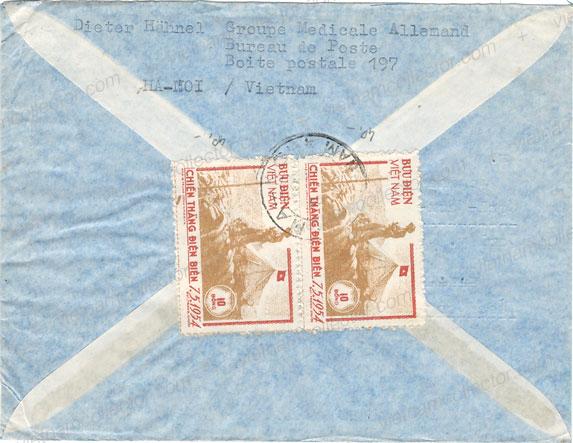
Mixed franking of the 20D and 50D Agrarian Reform stamps together with the 500D Railroad stamp paying the correct postage of 570D for an international air mail letters of up to 5g sent in April of 1956 from Hanoi to East Germany.
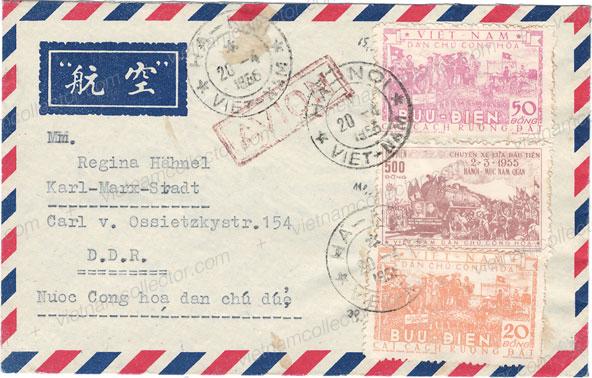
Another letter from an East German Doctor staying in the Lam Son Hotel in Hanoi and addressed to his personal assistant in East Berlin. It is another mixed franking. This time of the brick red Michel Nr. 41aI, the 500D Railway and 50D Agrarian Reform stamp paying an overall postage of 570D which is the correct tariff for an air mail letter at that time.
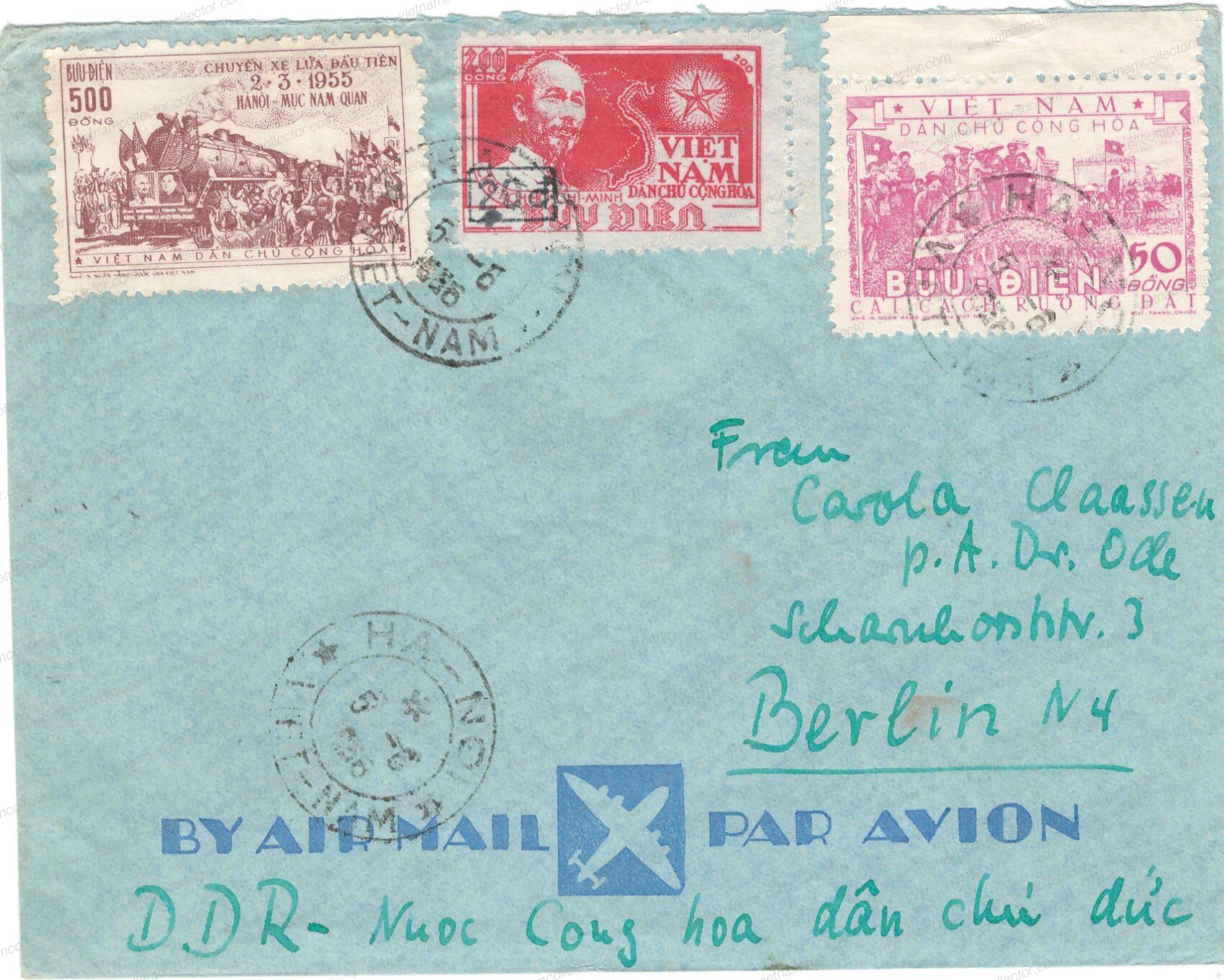
Here is an interesting letter (ex Klewitz) that features a mixed currency franking. One can see that the Five Year Plan issue was printed attached to each other on one sheet. The letter also nicely illustrates that North Vietnamese stamps retained their validity forever. The 100 Dong railroad stamp from 1956 had been devalued in March of 1959 by 1,000:1, which meant it was only worth 10 xu at the time of use. The overall franking hence amounted to 1.12 Dong which was just a whisker above the require rate of 1.10 Dong.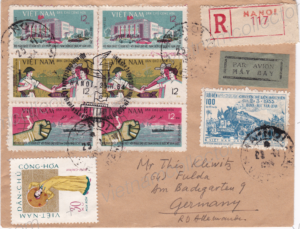
Mixed currency mailing from the Vietnamese Red Cross to the Red Cross Headquarters in Geneva, Switzerland using four stamps denominated in Old Dong (Railroad and Handicraft sets) in the amount of 3,000 Old Dong (worth only 3 New Dong after the 1,000:1 devaluation on March 1st, 1959). Stamps in New Dong were added in the amount of 1.53D were added for an overall postage of 4.53 New Dong. The letter carries also an imperforate 50xu stamp of the 1962 Flower set. Imperforate stamps on postally used cover are very rare.
Letter mailed in August 1956 from the Ministry of Public Health in Hanoi to Sofia, Bulgaria. Interesting “Air Mail” cachet on front describing the air route from Hanoi to Canton. The other hand stamp “Apres depart” was applied to signify to the post office that the letter was franked by the sender and hence additional scrutiny regarding the correct postage was in order. Arrival machine stamp dated September 21st, 1956 on the reverse. The letter is franked with two 200D railroad stamps and 500D of the production and thrift issue for a total postage of 900 Dong.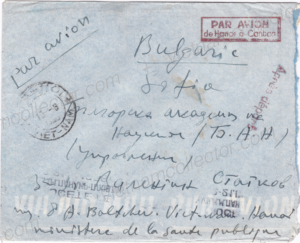
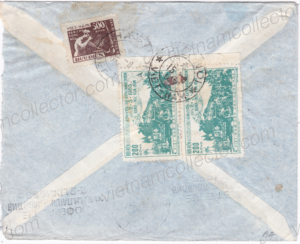
The same franking of 900 Dong was applied on this letter from an employee of the East German Embassy to East Germany. Mailed on October 23rd, 1956.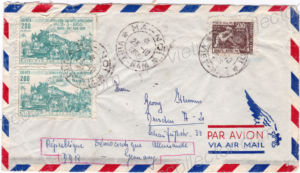
Letter mailed on June 21st, 1956 from the East German Embassy to East Germany. This one is franked with a pair of 300D railroad stamps for a total postage of 600D.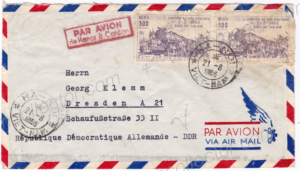
Here is a postcard mailed on August 2nd, 1956to Czechoslovakia. It is franked with a single 500D railroad issue.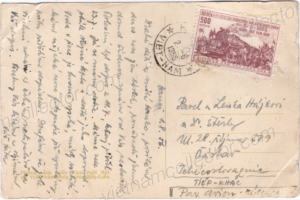
Below is a letter from April 7th, 1956 from hotel in Hanoi to the General Secretary of the National Committee of Korea and Vietnam in Berlin, East Germany. It is franked with a single stamp 500D railroad and two additional stamps of the land reform issue for a total franking of 570 Dong. So, it appears that letters were only a little bit more expensive than postcards.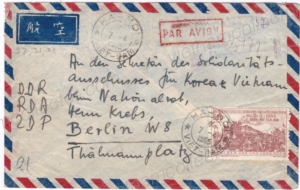
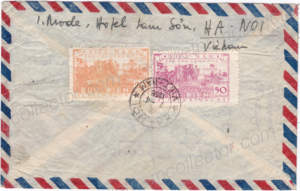
Registered letter from Hanoi to Fulda, West Germany (June, 1956). Early letters to the West, especially registered ones, are particularly rare (ex Klewitz). This one is franked with a pair each of the 200D and 500D railroad series plus other early NVN stamps for a total postage of 1,440 Dong. Fulda arrival cancel.
Mixed franking of the 500D Railroad stamp plus the 1,000D Return of the Government stamp paying an overall postage of 1,500D on a very rare registered air mail letter sent from Hanoi to Germany in December of 1956. The 5g base rate for a letter at the time amounted to 300D plus 270D air mail surcharge and 600D registration surcharge. So this letter must have weighed a multiple of 5g. Ex Klewitz.
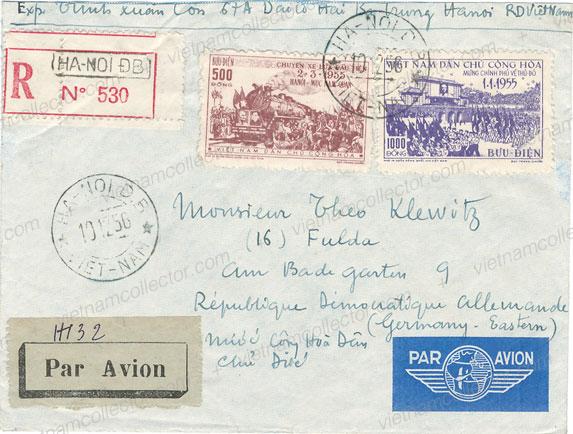
Below is a registered letter from August, 1956 from the commercial section of the Czechoslovakian Embassy to Chechoslovakia featuring one 300D and two 500D values of the railroad issue along with other early NVN stamps for a total postage of 1,480 Dong.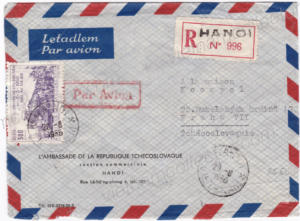
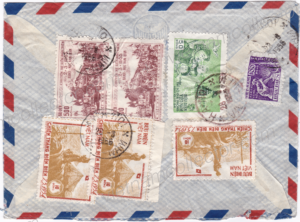
Letter front with very interesting Hanoi-Gare (Hanoi Railway Station) R-label and very unusual “Hanoi” line cancel. The R-Label must have been a carry over from the departed French administration. Part of a registered letter sent to the Foreign Affairs Ministry in Bulgaria. It is franked with three 500D railroad stamps and other early NVN stamps for a total postage of 1,710 Dong.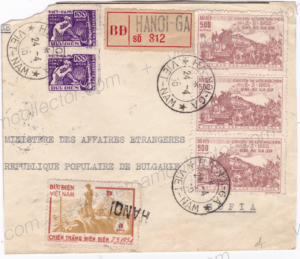
Here is a letter that features one of the 100 Dong railroad stamps and that shows an interesting mixed currency franking of old and new Dong (ex Klewitz). The railroad stamp on the reverse of 100 Old Dong was worth only 10 xu in 1966 (after having devalued 1,000:1 in March of 1959), so the overall franking of the letter mounted to 1.12 Dong. That was just a tad higher than the required tariff of 1.10 Dong for a registered letter to West Germany.
Registration Nr. 100035

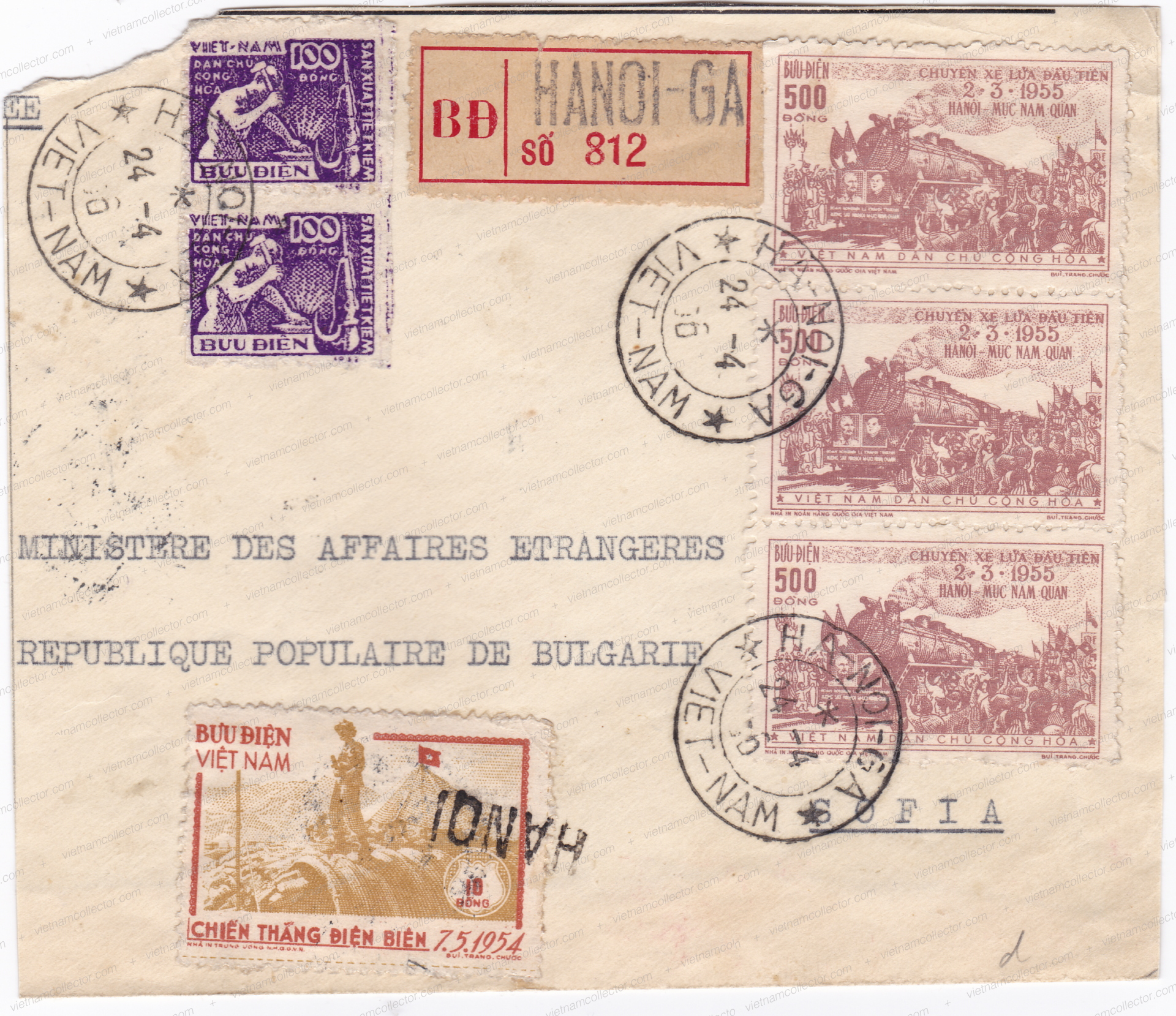
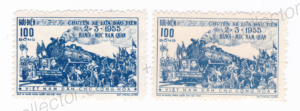
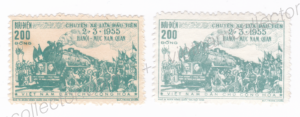
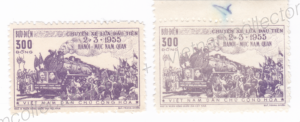
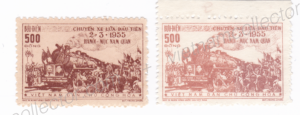
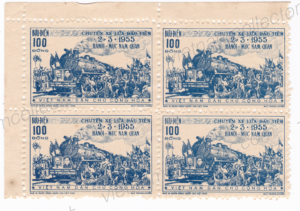
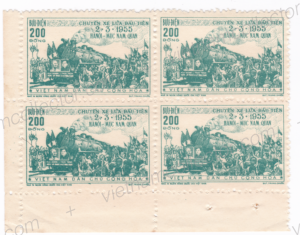
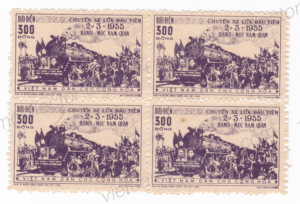
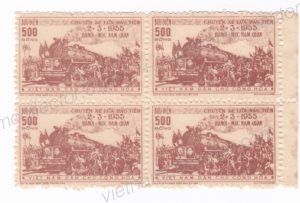

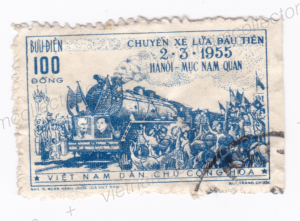
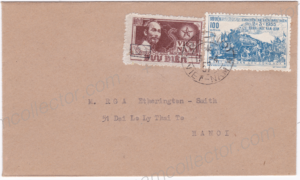
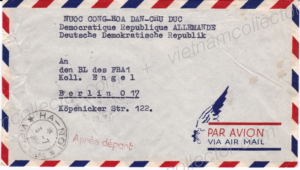
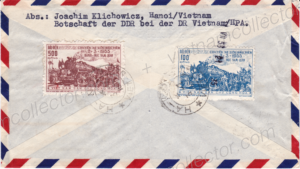
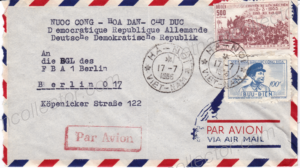
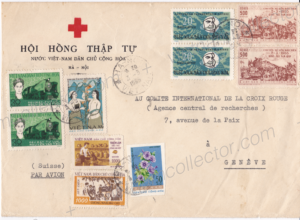
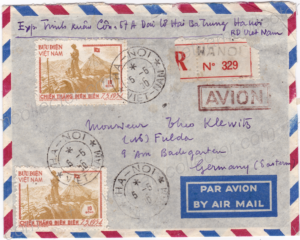
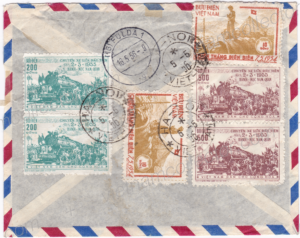
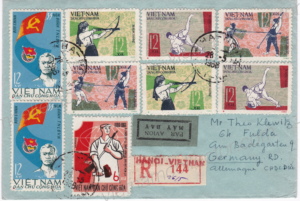

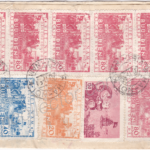
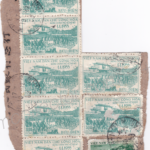


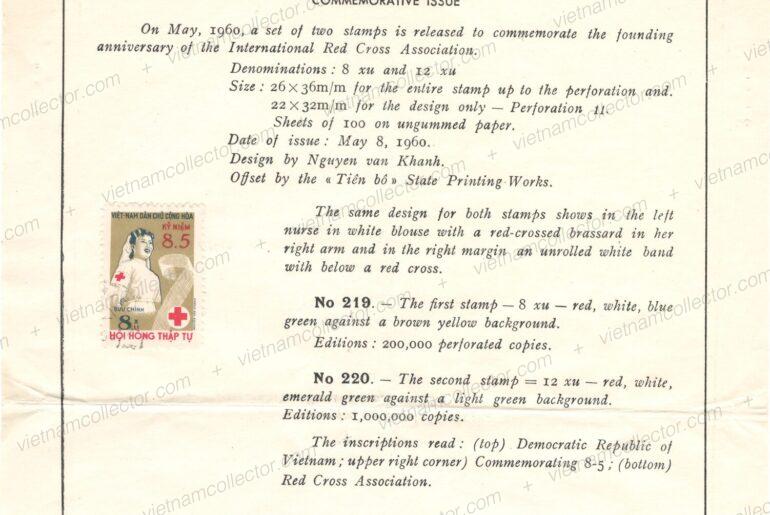
Comments are closed.